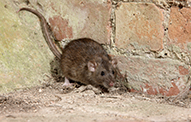
Brejtësi i qatisë
Pesha: 140 deri në 280 gram
Madhësia: Brejtësi i qatisë është zakonisht rreth 38 cm i gjatë dhe kanë një bisht të gjatë pa qime që mund të jetë rreth 35 cm i gjatë
Ngjyra: E zezë e lehtë në gri me qime të lëmuar në trupat e tyre me nënbarkë të bardhë në gri
Sjellja socilae e brejtësit të çatisë
Siç tregon emri i tyre, minjtë e çatisë zakonisht bëjnë fole lart mbi tokë në pemë, shkurre të larta të rritura ose bimësi të dendur. Brejtësit e qatisë janë alpinistë të shkëlqyer dhe shpesh hyjnë në shtëpi duke vrapuar përgjatë degëve të pemëve, kabllove ose telave. Në ndërtesa, brejtësit e qatisë zakonisht folezojnë në pjesën e sipërme të strukturave në hapësira të mbyllura ose të ngritura, mure, tavane të lëshuara dhe kabinete. Ata janë shumë të shkathët dhe mund të depërtojnë përmes vrimave vetëm 1,27 cm të gjera.
Brejtësit e qatisë udhëtojnë në mënyrë rutinore deri në 100 metra për ushqim. Ato shpesh mund të shihen gjatë natës duke vrapuar përgjatë linjave ajrore ose majave të gardheve. Ata kanë një ndjenjë të shkëlqyer ekuilibri dhe përdorin bishtin e tyre të gjatë për të mbajtur stabilitet gjatë lëvizjes përgjatë linjave ajrore. Ata lëvizin shpejt gjë që u mundëson atyre të shpëtojnë nga grabitqarët.
Duke pasur parasysh historinë e tyre të shkaktimit të dëmeve (gërryerja përmes instalimeve elektrike, kontaminimi i ushqimit, etj.) dhe problemet shëndetësore (vektorët e salmonelës, tifos së mykut, etj.), është e rëndësishme që pronarët e shtëpive apo bizneseve të kuptojnë se si të identifikojnë brejtësit e qatisë dhe bizneset të kuptojnë se si të mbrohen nga këta dëmtues të kushtueshëm.
Habitati
Specialist në ngjitje
Mund të hyjë në struktura përmes pemëve, linjave të energjisë
Të ushqyerit
Ka një preferencë për ëmbëlsinë e frutave
Megjithatë, do të ushqehet me çdo gjë, duke përfshirë ushqimin për kafshët shtëpiake
Ka nevojë çdo ditë për ujë
Mbrojtja
Përdorni rrjete metalike për të mbyllur vrimat e hapura, veçanërisht në hapësirat e zvarritjes dhe çatitë
Eliminoni grumbujt e mbeturinave jashtë ndërtesës
Sigurohuni që kontejnerët e plehrave të jenë të mbyllura mirë
Eliminoni burimet e mundshme ushqimore si ushqimet e mbetura për kafshët shtëpiake dhe drithërat e ndryshme
Prisni bimësinë për të parandaluar që të bëhet tepër i dendur
- Kafshimet e miut dhe trajtimi
- Si të mbrohemi nga brejtësit
- Shqetësimet shëndetësore nga brejtësit

